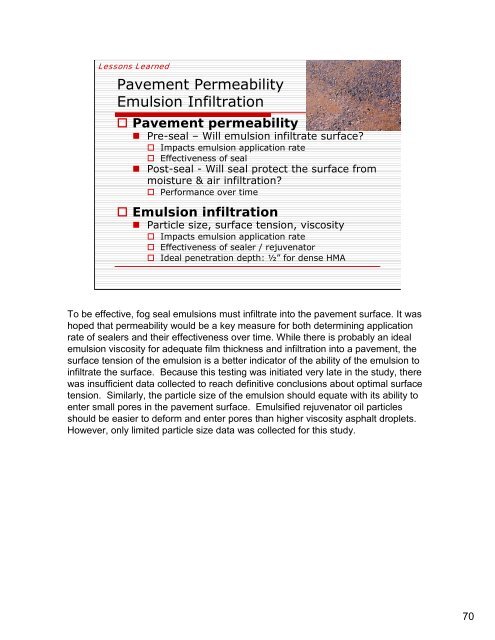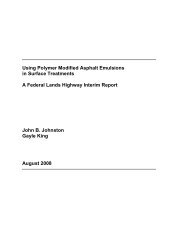Spray Applied Polymer Surface Seals - TSP2
Spray Applied Polymer Surface Seals - TSP2
Spray Applied Polymer Surface Seals - TSP2
You also want an ePaper? Increase the reach of your titles
YUMPU automatically turns print PDFs into web optimized ePapers that Google loves.
Lessons Learned<br />
Pavement Permeability<br />
Emulsion Infiltration<br />
Pavement permeability<br />
• Pre-seal – Will emulsion infiltrate surface?<br />
Impacts emulsion application rate<br />
Effectiveness of seal<br />
• Post-seal - Will seal protect the surface from<br />
moisture & air infiltration?<br />
Performance over time<br />
Emulsion infiltration<br />
• Particle size, surface tension, viscosity<br />
Impacts emulsion application rate<br />
Effectiveness of sealer / rejuvenator<br />
Ideal penetration depth: ½” for dense HMA<br />
To be effective, fog seal emulsions must infiltrate into the pavement surface. It was<br />
hoped that permeability would be a key measure for both determining application<br />
rate of sealers and their effectiveness over time. While there is probably an ideal<br />
emulsion viscosity for adequate film thickness and infiltration into a pavement, the<br />
surface tension of the emulsion is a better indicator of the ability of the emulsion to<br />
infiltrate the surface. Because this testing was initiated very late in the study, there<br />
was insufficient data collected to reach definitive conclusions about optimal surface<br />
tension. Similarly, the particle size of the emulsion should equate with its ability to<br />
enter small pores in the pavement surface. Emulsified rejuvenator oil particles<br />
should be easier to deform and enter pores than higher viscosity asphalt droplets.<br />
However, only limited particle size data was collected for this study.<br />
70
















